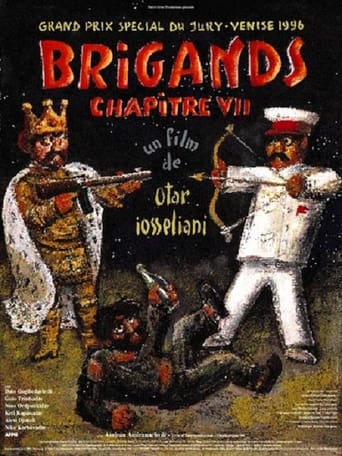Cristi_Ciopron
What are the features of Iosseliani's cinema?It is so savory,so fresh,so intelligent,so original,ironic,unconventional, inspiring.The Carnivalesque and conventional barbarity of the medieval scenes is strongly contrasted with the cold cruelty of those settled during the Communist epoch.Brigands, Chapitre VII (1996)'s theme is a historical one:the Communism 's atrocities are keenly investigated.The conception is a phenomenological one:it shows the facts in themselves.The content's treatment is calligraphic,and of a wonderful transparency.Each frame is minutely composed,and almost any scene has a joke or a gag.There is no lumber.Despite its relatively big length,the show excels in in concision and its narration is lapidary,succinct,elliptical.Otar Iosseliani's gusto,and the make-up's economy,are delightful;he uses a refined photography and chromatic.In a playful and funny note,that only serves his fundamental sobriety and propriety,Otar Iosseliani is caustic,sarcastic, incisive,clever.The scent of the torture tools;a schoolboy's denunciations include his father and his teacher.The jail,then the lock-up,the dead's stretcher, the death's corridors,swallow step by step everybody.The terrorist system devours itself,but its reserves ,its resources are huge.An executioner drinks water from his palm's dipper sullied with his victim 's blood.The segments about the Communist world are rending,in their concision.The stretchers are covered by shrouds.The executioner's son is invited to watch his father's trade,from behind a screen;when the boy goes out in the street,he describes enraptured to his mother the methods he saw.His father is a tall man,with long,expressive,nimble hands.The unbelievable violence of the Communism ,the absurd of a civil war nowadays,are graphically presented.There is an in-exhausted artistic plenitude in this movie that expounds the Communism's wickedness,corruption, dishonesty,ill nature;unlike other anti-Communist shows,this one does not scoff at the collectivism's folly and very low human level.It grasps its devilish,cruel,measureless wrong-doing.This stripping of the accessory,this appeal to the comic's categories strengthen the impression of meaningful realism.Caustic and sardonic realism:of the historical content,of the themes,of the facts;the freshness of the approach,the striking gist of the story.The tact excludes all exaggeration.Iosseliani has much to say,and Brigands, Chapitre VII (1996) is never an empty,formal exercise.
ruben-heim
This picture interlinks three stories on three different time levels. It starts in the present; today's Georgia is shaken by riots. Three friends are muddling through. Soon we concentrate on one of them. He plays a leading role every time. First as a medieval prince, than as a local officer of the Communist NKWD under Stalin. Those three levels are constantly referred to; they add to each other in a flow. Iosseliani has the same cast acting on all those levels. Every new entrance of the same actors in each episode underlines the continuity of occurrences in the flow of time. Despotism and terror rule at any time, injustice and bloodshed return eternally. It is for Iosseliani's craftsmanship that, along with all that bitter realization, there comes fun.
a_drew_k
i suppose the trick while watching Ioseliani's movies is to take them just as they are. trying to conceptualize them as less as possible. movie figure out the ideas himself while head is tranquil and mind is open. the colors, the visual series seems to be rather not less important then the plot gimmicks and characters. and all together it's a very special flow if perception. personally i enjoyed it a lot. i really liked his way of seeing.
Grégoire "Freak" Dubost
if i hadn't seen his Otar Iosseliani's next film, 1999's masterpiece "Adieu, Plancher des vaches !". So my comment will probably be linked to the two films rather than only to this particularly strange journey, adrift in a Parisian's tramp mind. War is the main thread that links his dreams, as he embodies a medieval king, or a communist leader, or remembers of his east-european country, ravaged by war. But more interesting is the permanent obsession, for Iosseliani, of typical features like Cinema in itself, Paris, where the director actually lives (he's from Georgia), tramps, alcohol and songs. The scenes which I think are 'real' in opposition to 'dreamt' ones, mainly show the hero, with his unfortunate friends, but still happy singing beautiful harmonies. Just like the last scene (and others) from "Adieu,..". It is a bit difficult to follow the plot, since there are so many different ages edited together, but as the very first sequence shows us, this is only Cinema. So just let your mind wander with the pictures.


 AD
AD
